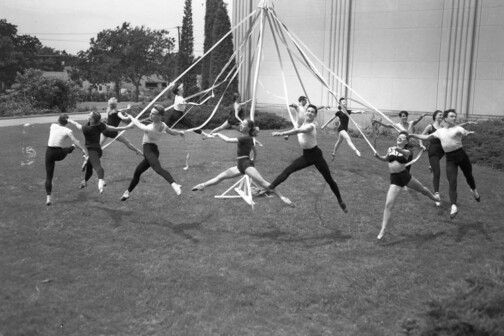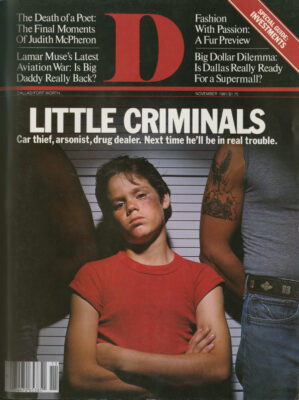TEXAS, the only state to win a war in its own name and under its own national flag, is at battle again. This time we’re fighting the war against crime, and to hear some tell it, crime has a short time to go down here, and the pushing of drugs has but one noise to make: the death rattle. The hero, they claim, is the new electronic surveillance law. Others, however, suggest we keep our wagons circled. They fear the law has added scant firepower to the crime-fighting armory.
It was only after a peppery statehouse scuffle that lawmakers gave us “electronic surveillance” and “covert entry” -legal lingo for “police wiretapping” and “police burglary-to-bug.” These centerfold beauties of Gov. Clements’ anti-crime package have been heralded as just the fighting utensils needed for the victory push. Time -as usual -will tell.
Wiretapping and burglary are lateblooming lawmen’s tools. As early as 1861, with our Civil War about to begin, states outlawed unauthorized interception of telegraph messages. Law enforcers waited until 1968 to get the wiretapping go-head (except during a six-year span ending in 1934). It was 1979 before the United States Supreme Court read into law the notion that burglary-to-bug (breaking into a building to install, a wiretap) had been approved by Congress.
Wiretapping was first made legal in 1928 when Chief Justice William H. Taft, speaking for five justices against four, reasoned that “one who installs in his house a telephone instrument. . .intends to project his voice to those quite outside,” ruling, then, that messages that passed through wires are not protected by the Fourth Amendment. Justice Oliver Wendell Holmes Jr. disagreed and filed a dissenting opinion that went little beyond a simple declaration that no American court should condone the “dirty business” of wiretapping.
In 1934 Congress agreed with Holmes and passed the Communications Act, which outlawed the unauthorized interception of wire communications and set heavy penalties for violations. In theory, at least, citizens -private or public -who tapped telephones asked for a lot of trouble. It did not turn out that way. Thirty-five years later no law officer had been prosecuted under the Communications Act, and less than a dozen private citizens had been charged. Protection of individual privacy has not been a top law enforcement priority for many decades.
In 1968 legalization of police wiretapping picked up steam. President Johnson sent Congress his proposed Safe Streets Act, and Congress passed it and sent back much more than what the president wanted; his Safe Streets Act now legalized court-supervised wiretapping and told the states they were free to do the same.
The president signed the Safe Streets Act, but unwanted congressional wiretap authorization caused him to call for revision of the act even as he approved it. In his formal statement of approval on June 20, 1968, the president told the country what he thought of the wiretap provision:
“The Congress, in my judgment, has taken an unwise and potentially dangerous step by sanctioning eavesdropping and wiretapping by federal, state and local officials in an almost unlimited variety of situations. If we are not very careful and cautious in our planning, these legislative provisions could result in producing a nation of snoopers bending to the keyholes of the homes and offices in America, spying on our neighbors.”
Years of watching police use the eavesdropping power did not shift Johnson’s belief that Congress had done him – and us -wrong. His autobiography, The Vantage Point, makes it clear that life out of the White House, as well as Peder-nales musings, only heightened his dismay at what Congress had done:
“The act had a rough passage through Congress, a circumstance not entirely unexpected, since it was the first major anti-crime legislation of its kind. When it was finally passed, the act contained one major disappointment -a provision for wiretapping, which I considered a grave danger to our constitutional rights. Privacy is among the most basic rights of the individual and is too precious to be violated by electronic snooping. The case for wiretapping has never been adequately established in my judgment. It has rarely proven effective and often has just offered a lazy substitute for sound police work.”
The new Texas law imitates the wiretap parts of the Safe Streets Act with one important exception: Texas lawmen can apply for interception authorization only in cases involving claimed violations of state drug laws. The kidnappers, murderers, rapists, robbers, embezzlers, arsonists and the like are not to be bothered unless-quite coincidentally -they are drug-dealing big game.
Before a telephone is tapped or a bug-burgle is executed, the Texas lawman sets off a chain of paper work. The detective, for example, asks his boss to apply for tapping or burgling permission, or both. The boss then makes a written application to the director of the Texas Department of Public Safety, who decides whether or not there is a need for the tap or bug, and whether lawmen are capable of undertaking the action. Capability comes into question because local lawmen commit a crime if they “own, possess, install or operate” intercepting devices. Furthermore, a commissioned officer of the Texas Department of Public Safety must be present at all times during the surveillance, and local lawmen may only assist. If the director has the commissioned officers for the job, he may give written approval to the local prosecuting attorney, telling the district attorney that it is all right to apply to the district judge for permission to go ahead.
Almost all Texas district judges are denied the power to grant or refuse wiretapping authority, much in the way that local lawmen are not to do more than assist the DPS folks. Only nine judges in the state may authorize or refuse applications. These nine are appointed by the presiding judge of the Court of Criminal Appeals and serve at his pleasure.
The job of the nine judges is little different from the job of a justice of the peace who reviews a lawman’s application for a search warrant. The papers must be in apparent order, probable cause must appear from the affidavits and a need for the interception must be shown. If the judges say yes, the interception can go on for only 30 days unless an application for extension is made and approved.
With the judge’s order of approval in hand, and with commissioned officers of the Department of Public Safety assembled in such numbers as to have one present at all times, the law officer is ready to start hearing and recording what the target telephone lines carry, and if authorized, to begin the covert entry that will put the electronic bug in its secret place. Proof of where this might lead us in the war against Texas crime might be found in the 13 years of federal electronic eavesdropping.
During the 1968 congressional debate on the wiretap sections of the Safe Streets Act, no one doubted that organized crime was enormously threatening to the nation and was little touched by police efforts. It soon followed that a majority of both houses decided that the threat wiretapping placed on citizen privacy was a small price to pay for putting an end to organized crime. Police wiretapping was what America needed. Voters believed these brave men of vision. It didn’t work, but years went by before we were sure of it.
Voters forgot who promised what. It is the promise of the moment – the one untried – that counts heaviest.
For Texas legislators, giving up a little citizen privacy was a small price to pay for what electronic surveillance would do to – and about -major drug dealers. Lacking enough proof to wad a shotgun, otherwise responsible public figures tried to make a case that wiretapping and bugging were the answer to our drug threat and that drugs were the fountainhead of Texas crime.
When Clements signed the electronic interception bill into law, politicians of differing stripes claimed a death blow had been delivered to Texas’ larger dope dealers. The promise has been made; we await its fulfillment. Meanwhile, it may not be too far-fetched to predict that if the big drug pushers of Texas suffer as little under the death blow of Texas’ electronic surveillance as organized crime has suffered under 13 years of federal electronic surveillance, marijuana will soon come down in price and go up in quality.
No one claims that federal lawmen, the FBI, the Drug Enforcement Administration and customs officials are less diligent peace officers than what we have in Texas. James Adams, director of the Texas Department of Public Safety, brought about 30 years of experience as an FBI agent to the department when he took on his new job. The point to be made is that Texas peace officers are likely to see and use their new interception capability in ways not too different from their federal counterparts.
There is evidence that federal peace officers rely heavily on other methods in drug investigations, with wiretapping riding in the back seat. In 1971, three years after it was legally possible to do so, federal law enforcers made only 22 applications for wiretap authority in drug cases. These figures are for all 50 states. In the same year, extortion and loan-sharking (crimes closely associated with the violent side of organized crime) accounted for all but two applications. Gambling cases accounted for almost 250 applications in the same year.
From the beginning, federal officers spent most of their wiretap energies against sports betting, an activity peculiarly vulnerable to wiretapping, but as widespread as -and more resilient than – the common cold. Although a few bookmakers have been convicted, their clients -overwhelmingly from the middle class -never missed a bet. It seems as though two bookmakers take the place of every one that is sentenced. And for what it is worth, a Texas bookmaker is about as likely to be connected with organized crime as he is to be connected with the Chinese army.
At a time when the nation’s crime rate – including drug dealing-soared, federal law officers thought it wise to cut back on wiretapping. In 1973 a total of 864 applications to wiretap were made; by 1979 the total had dropped to 553. One senses that those who enforce the law see wiretapping as less than the crime war super-weapon lawmakers claim it to be.
The collection of crime statistics is a growing industry. Statistics abound -as do conflicting interpretations of them -but all show that things are getting much worse. A nation that for 200 years has been pursuing domestic tranquility cannot neglect this grisly statistic: In 1974 a Massachusetts Institute of Technology study told us that “an American boy born in 1974 is more likely to die by murder than an American soldier in World War II was to die in combat.” The outlook is no better for boys born today.
On Oct. 1, 1981, the Texas Department of Public Safety released figures showing that at least 800,000 urban-dwelling Tex-ans will be major crime victims (murder, rape, robbery, aggravated assault, burglary, theft, car theft) in 1982. The same figures show that there will be an arrest made in less than one out of five of these cases, and far fewer will be prosecuted. If you take your own personal odds into consideration, chances are nearer one in 13 that you will make the victim list.
Chief Justice Warren Burger came to Texas last February and told us that “crime and fear of crime have permeated the fabric of American life.” He’s right. But, a greater fear is that apathy will let us go on under a crippled system of feebly supported, paid and staffed criminal courts, prosecutors’ offices and police agencies. As Burger pointed out, “Freedom from this fear will be costly in the short run, and the short run will not be brief.”
It is not enough to say that drugs are the key to the problem. Our answer -if we find it – will not be in slogans, electronic tools or the lowering of our standards of constitutional liberty. The key to whatever victory we are to have lies in the taxpayers’ willingness to bear the enormous cost of a criminal justice system that works.
Related Articles

Visual Arts
Raychael Stine’s Technicolor Return to Dallas
The painter's exhibition at Cris Worley Fine Arts is a reflection of her training at UTD—and of Dallas' golden period of art.
By Richard Patterson

Dallas History
Tales from the Dallas History Archives: Scenes from 1949, When the Mob Ruled Dallas
In 1949, streetcars still roamed Dallas' streets, the Adolphus Hotel towered over its neighbors downtown, the State Fair was still segregated, and Benny Binion wanted his money.

Business
Executive Travel: Beverly Hills, California
The Maybourne Beverly Hills is a luxurious home base to explore the best of Los Angeles, a frequent destination of Alto CEO Will Coleman.
By Will Maddox


